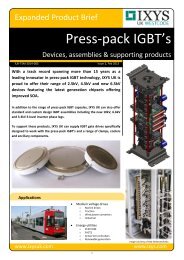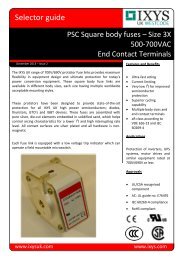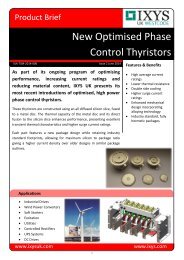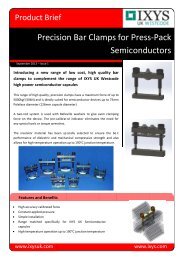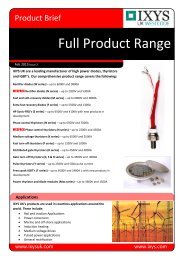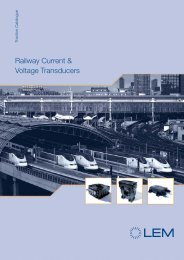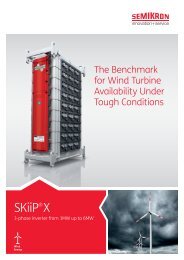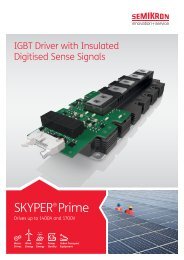isolated current voltage transducers
You also want an ePaper? Increase the reach of your titles
YUMPU automatically turns print PDFs into web optimized ePapers that Google loves.
Hall Effect Technologies<br />
specified measuring range; a check on the transducer<br />
secondary side is required to see if this transient<br />
measurement is nevertheless possible<br />
For the latter point, as discussed in § 3.2.10 – example 2,<br />
it is sometimes possible to measure a <strong>current</strong> beyond that<br />
specified in the transducer datasheet, more precisely<br />
when the measurement resistor is not exceeding a<br />
maximum R Mmax<br />
value. In this example, we have:<br />
• the conversion ratio of the transducer is 10000 / 2000,<br />
giving a secondary <strong>current</strong> of I S<br />
= 5 • 21.8 = 109 mA<br />
• the <strong>voltage</strong> available at the amplifier output is (Fig. 12)<br />
V A<br />
= (R S<br />
+ R Mmax<br />
) • I S<br />
= (60 + 150)Ω • 50 mA = 10.5 V<br />
• the maximum measurement value is<br />
R Mmax<br />
= (V A<br />
/ I S<br />
) -R S<br />
= (10.5 / 0.109) – 60 = 36.3Ω<br />
In conclusion, measuring a 500 V transient is possible if a<br />
measurement resistance lower than 36.1 Ω is used.<br />
c) Measurement accuracy: influence of the serial resistance<br />
R 1<br />
and primary resistance R P<br />
The measurement principle discussed in § 3.4.1 is based<br />
on the measurement of a <strong>current</strong> I mes<br />
(Fig. 21) proportional<br />
to the <strong>voltage</strong> to be measured. The two main factors<br />
affecting the measurement accuracy are:<br />
• The accuracy of the measurement of the collected<br />
<strong>current</strong> I mes<br />
• Unexpected changes of the ratio between the collected<br />
I mes<br />
<strong>current</strong> and the <strong>voltage</strong> to be measured.<br />
Thus, changes of the resistances R 1<br />
and R P<br />
will affect the<br />
measurement accuracy, since it will change the value of<br />
the I mes<br />
<strong>current</strong>.<br />
The example below calculates the impact on accuracy of<br />
a change in resistances, due to both resistance tolerances<br />
and temperature effects. A LV 100 <strong>voltage</strong> transducer is<br />
considered, with a +20°C to +70°C worst case working<br />
temperatures.<br />
Reference case<br />
The reference value of the <strong>current</strong> to be measured, I mes<br />
, is<br />
defined as the value obtained at +70°C when both<br />
resistors R 1<br />
and R P<br />
have their nominal value. These<br />
values are R 1<br />
= 21.0 kΩ (as calculated in point a), at<br />
+70°C) and R P<br />
= 1.9 kΩ (data-sheet, measured value).<br />
The collected I mes<br />
<strong>current</strong> is then equal to 230 V / (21 +<br />
1.9) kΩ = 10 mA<br />
Maximum error<br />
The value of the resistances are smaller at +20 °C when<br />
compared to +70 °C. The worst case shall additionally<br />
consider the tolerance on the resistances' value when at<br />
their minimum.<br />
For the resistance R 1<br />
, typical values for the temperature<br />
drift and tolerance are 50ppm/°C and ± 0.5% respectively.<br />
The minimum value becomes:<br />
R 1<br />
= 21’000 • (1 - 50 • 50 • 10 -6 ) • (1 – 0.005) = 20’942 Ω<br />
The primary resistance R P<br />
is made of copper and exhibits<br />
a resistance change with temperature as follows:<br />
R PF<br />
= R P20<br />
(1 + α • ∆T) where<br />
R PF<br />
: resistance at Final temperature (e.g. +70 °C)<br />
R P20<br />
: resistance at +20 °C<br />
α : copper temperature coefficient = 0.004 K -1<br />
∆T : change in temperature (Final – 20 °C), positive<br />
when above +20 °C<br />
Note that the temperature of the R P<br />
copper is likely to be<br />
higher than the maximum ambient temperature due to<br />
internal transducer heatings.<br />
In our case:<br />
R P20<br />
= 1’900 / (1 + 0.004 • 50) = 1’538 Ω<br />
Collected <strong>current</strong> become equal to I mes<br />
= 230 V / (20’942 +<br />
1’538) = 10.21 mA, corresponding to a +2.1 % error<br />
compared to the reference value.<br />
The measurement accuracy of the I mes<br />
<strong>current</strong> has still to<br />
be added to this 2.1 % error.<br />
d) What is the accuracy of the transducer, converting the<br />
primary <strong>current</strong> into an <strong>isolated</strong> output signal ?<br />
In this case, we assume that the resistor R 1<br />
has been<br />
selected in order to have a 10 mA primary <strong>current</strong> I PN<br />
.<br />
According to the LV 100 datasheet, the accuracy of the<br />
<strong>current</strong> measurement at 25 °C is ±0.7 % of I PN<br />
. The<br />
thermal drift of the offset <strong>current</strong> is ±0.3 mA max. With a<br />
conversion ratio of 10000:2000, the input <strong>current</strong> of<br />
10 mA generates an output <strong>current</strong> of 50 mA. The values<br />
of the errors are:<br />
Accuracy at 25 °C ±0.7 % of I PN<br />
±0.7 %<br />
Temperature offset drift ±0.3 mA/50 mA ±0.6 %<br />
Maximum error of the <strong>current</strong> measurement: ±1.3 %<br />
e) What is the total measurement error?<br />
The effects listed in c) and d) above provide the total<br />
measurement error of the output <strong>current</strong> of the transducer.<br />
Typical applications include a measuring resistance, R M<br />
,<br />
to convert this output into a <strong>voltage</strong> for measurement.<br />
Assuming typical parameters for R M<br />
, we have an intial<br />
tolerance of ±0.5 % and a 50 ppm/K temperature drift,<br />
giving a 0.225 % variation for a 20 °C to 70 °C<br />
temperature range. The total R M<br />
error becomes 0.5 +<br />
0.225 = 0.725 %.<br />
For the LV 100 transducer, the total measurement error at<br />
the 230 V nominal, considering a temperature range of<br />
20 to 70°C, is the combination of the effects in c) and d)<br />
and R M<br />
above:<br />
total measurement error =<br />
2.1 % + 1.30 % + 0.725 % = 4.125 %<br />
23





